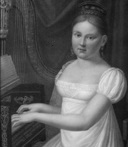Marianna Bottini facts for kids
Marianna Bottini (born Motroni-Andreozzi) was an Italian composer and a teacher of the harp. She was born in Lucca on November 7, 1802. Her father, Sebastiano Motroni-Andreozzi, was a nobleman, and her mother was Eleonora Flekestein.
Her Life and Music Journey
Marianna Bottini showed great musical talent from a young age. She studied a complex way of composing music called counterpoint with a teacher named Domenico Quilici. Counterpoint is about combining different melodies that sound good together.
In 1820, when she was just 18, Marianna was accepted into the Accademia Filarmonica in Bologna. This was a very important music academy. They recognized her skill by naming her an 'honorary master composer.' This was a big achievement, especially for a woman in those times!
In 1823, she married Lorenzo Bottini. He was a marquis, which is a type of nobleman, and an important person in politics. This meant he was involved in leading the city.
Marianna Bottini was one of the few women composers whose music was performed at a special festival. This festival honored Saint Cecilia, who is the patron saint of music. Marianna Bottini passed away in Lucca on January 25, 1858.
Her Compositions
Marianna Bottini wrote most of her music when she was quite young, between the ages of 13 and 20. She composed pieces for private concerts, often held in people's homes (called salons), and also sacred music for churches.
Here are some examples of her works:
- Elena and Gerardo: This was an opera she wrote in 1822, but it was never performed.
- In sacred hymns: A piece for three voices, wind instruments, and basso continuo (a type of musical accompaniment) from 1819.
- Briseis: A cantata (a piece for voices and orchestra) from 1820.
- Cantiamo Pastori: Another cantata for five voices and orchestra.
- Motet for one voice and orchestra (1818 and 1819).
- Qui Tollis: A piece for one voice, chorus, and orchestra from 1818.
- Messa da Requiem: A special mass for four voices and orchestra, written in 1819.
- Mass for Saint Cecilia: A mass for four voices and orchestra, composed in 1822 for the festival honoring the saint of music.
- Clarinet concerto: A concerto is a piece for a solo instrument (like the clarinet) and an orchestra.
- Piano concerto "Concertone": A concerto for piano and orchestra, written in 1822.
- Symphonie for orchestra (1818) and for wind band (1819). A symphony is a large musical work for an orchestra.


